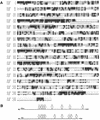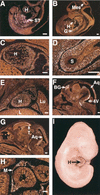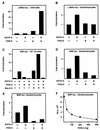FOG-2, a heart- and brain-enriched cofactor for GATA transcription factors
- PMID: 10330188
- PMCID: PMC104407
- DOI: 10.1128/MCB.19.6.4495
FOG-2, a heart- and brain-enriched cofactor for GATA transcription factors
Abstract
Members of the GATA family of zinc finger transcription factors have been shown to play important roles in the control of gene expression in a variety of cell types. GATA-1, -2, and -3 are expressed primarily in hematopoietic cell lineages and are required for proliferation and differentiation of multiple hematopoietic cell types, whereas GATA-4, -5, and -6 are expressed in the heart, where they activate cardiac muscle structural genes. Friend of GATA-1 (FOG) is a multitype zinc finger protein that interacts with GATA-1 and serves as a cofactor for GATA-1-mediated transcription. FOG is coexpressed with GATA-1 in developing erythroid and megakaryocyte cell lineages and cooperates with GATA-1 to control erythropoiesis. We describe a novel FOG-related factor, FOG-2, that is expressed predominantly in the developing and adult heart, brain, and testis. FOG-2 interacts with GATA factors, and interaction of GATA-4 and FOG-2 results in either synergistic activation or repression of GATA-dependent cardiac promoters, depending on the specific promoter and the cell type in which they are tested. The properties of FOG-2 suggest its involvement in the control of cardiac and neural gene expression by GATA transcription factors.
Figures






Similar articles
-
Molecular cloning of FOG-2: a modulator of transcription factor GATA-4 in cardiomyocytes.Proc Natl Acad Sci U S A. 1999 Feb 2;96(3):956-61. doi: 10.1073/pnas.96.3.956. Proc Natl Acad Sci U S A. 1999. PMID: 9927675 Free PMC article.
-
FOG, a multitype zinc finger protein, acts as a cofactor for transcription factor GATA-1 in erythroid and megakaryocytic differentiation.Cell. 1997 Jul 11;90(1):109-19. doi: 10.1016/s0092-8674(00)80318-9. Cell. 1997. PMID: 9230307
-
FOG-2: A novel GATA-family cofactor related to multitype zinc-finger proteins Friend of GATA-1 and U-shaped.Proc Natl Acad Sci U S A. 1999 Feb 2;96(3):950-5. doi: 10.1073/pnas.96.3.950. Proc Natl Acad Sci U S A. 1999. PMID: 9927674 Free PMC article.
-
Coregulation of GATA factors by the Friend of GATA (FOG) family of multitype zinc finger proteins.Semin Cell Dev Biol. 2005 Feb;16(1):117-28. doi: 10.1016/j.semcdb.2004.10.006. Epub 2004 Dec 15. Semin Cell Dev Biol. 2005. PMID: 15659346 Review.
-
Conserved cardiogenic functions of the multitype zinc-finger proteins: U-shaped and FOG-2.Trends Cardiovasc Med. 2001 Jul;11(5):185-90. doi: 10.1016/s1050-1738(01)00092-5. Trends Cardiovasc Med. 2001. PMID: 11597829 Review.
Cited by
-
ZEB1 imposes a temporary stage-dependent inhibition of muscle gene expression and differentiation via CtBP-mediated transcriptional repression.Mol Cell Biol. 2013 Apr;33(7):1368-82. doi: 10.1128/MCB.01259-12. Epub 2013 Jan 22. Mol Cell Biol. 2013. PMID: 23339872 Free PMC article.
-
Translational control of FOG-2 expression in cardiomyocytes by microRNA-130a.PLoS One. 2009 Jul 7;4(7):e6161. doi: 10.1371/journal.pone.0006161. PLoS One. 2009. PMID: 19582148 Free PMC article.
-
Direct reprogramming of human fibroblasts toward a cardiomyocyte-like state.Stem Cell Reports. 2013 Aug 22;1(3):235-47. doi: 10.1016/j.stemcr.2013.07.005. eCollection 2013. Stem Cell Reports. 2013. PMID: 24319660 Free PMC article.
-
A comprehensive gene expression analysis at sequential stages of in vitro cardiac differentiation from isolated MESP1-expressing-mesoderm progenitors.Sci Rep. 2016 Jan 19;6:19386. doi: 10.1038/srep19386. Sci Rep. 2016. PMID: 26783251 Free PMC article.
-
Multiple gene variations contributed to congenital heart disease via GATA family transcriptional regulation.J Transl Med. 2017 Apr 3;15(1):69. doi: 10.1186/s12967-017-1173-0. J Transl Med. 2017. PMID: 28372585 Free PMC article.
References
-
- Evans T. Regulation of cardiac gene expression by GATA4/5/6. Trends Cardiovasc Med. 1997;7:75–83. - PubMed
Publication types
MeSH terms
Substances
Associated data
- Actions
LinkOut - more resources
Full Text Sources
Other Literature Sources
Molecular Biology Databases
